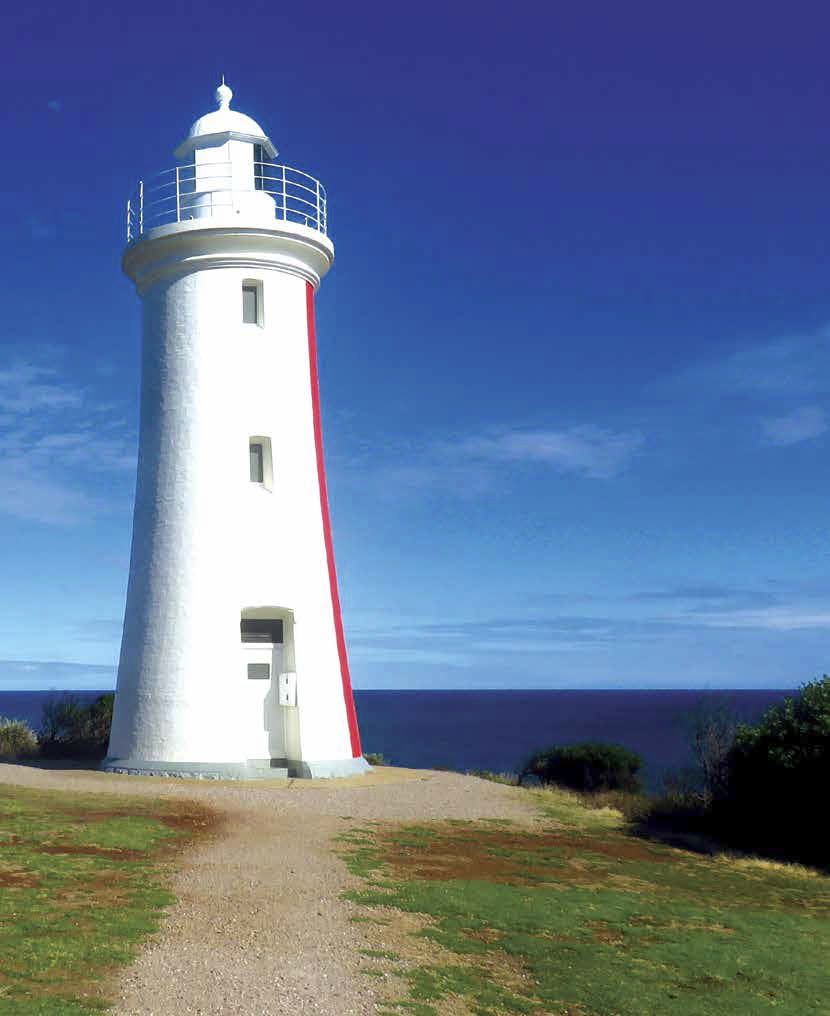
Mersey Bluff Lighthouse near the Mersey Bluff Caravan Park, Devonport
We have visited Tassie twice before. The first time was over 30 years ago before our kids were born. We purchased a package tour which included flights on a small plane to Launceston, a hire car, and predetermined accommodation stops to take us around the island and would take us to all of the essential places: Launceston, Mole Creek, Cradle Mountain, Queenstown, Strahan, Zeehan, Gordon River, Lake St Clare, Derwent Bridge, Hamilton, Hobart, Eaglehawk Neck, Port Arthur, and Ben Lomond — from memory.
Our second trip was about 15 years ago, and we took our two kids along and decided to hire an RV. On that trip we mainly visited other places as well as revisiting some from the first trip, including Hobart, Bruny Island, Freycinet Peninsula, Ross, Oatlands, Stanley, and The Nut. We had essentially already seen many of the popular places in Tasmania already.
On this trip — our third — we took our own little RV on the Spirit of Tasmania from Melbourne to Devonport. Our main aim for this trip was to try and get to places in Tassie that we had never been to before, aiming for places that were more unusual and out-of-the-way.
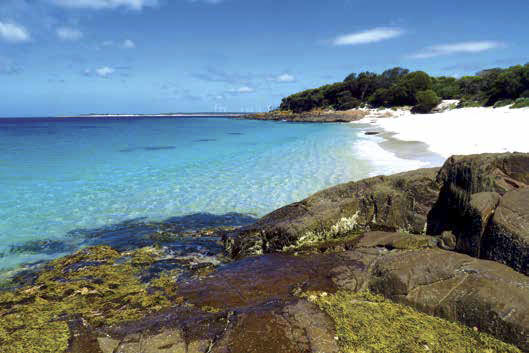
The beach at Petal Point looking towards the Tebrakunna Wind Farm at Little Musselroe Bay
ACROSS THE TOP
After a 10-hour daytime trip across Bass Strait we landed in Devonport and headed straight for our prebooked camp site at the Mersey Bluff Caravan Park at the Northern tip of Devonport. This is a great spot to stay while in Devonport with easy access to most things. You can also watch the ferry coming in and out of port! We spent two days touring Devonport — a lovely town except for the taste of the local water.
Heading east towards Exeter via the northern route, we walked around Narawntapu National Park where we found a marvellous bird hide and made a beeline for Bakers Beach.
After stopping at the Miners Museum at Beaconsfield where gold miners Brant Webb and Todd Russell were trapped for 14 days, we settled for the night at a free camp behind the Exeter Hotel. The next day we dropped into Grindelwald, a faux Swiss village, which was a bit too touristy for our liking. We then headed to the wonderful Tamar River, past Deviot, and crossed the Batman Bridge.
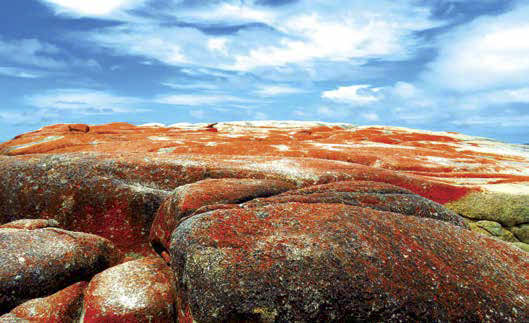
Flaming red rocks at the Bay of Fires
From there it was through to George Town and Low Head with its beautiful lighthouse, then Piper’s River and Piper’s Brook, down to the Bridestowe Lavender Estate at Nabowla. The lavender was in full glorious bloom across the rolling hillsides, and the large number of bees amongst purple flowers was a sight to behold. We spent that night at another nice free camp near Nabowla.
The fifth day of our journey took us to one of the major points of interest for this trip — the far north-east Corner of Tasmania — to Little Musselroe Bay and Petal Point via Bridport, the absolutely wonderful Tomahawk, Boobyalla, and Gladstone. It was a rough, potholed 30km trip from Gladstone via Rushy Lagoon to Little Musselroe Bay at Cape Portland to the extensive and impressive Tebrakunna Wind Farm. The latter is a joint venture between the Tasmanian and Chinese governments, and has a very informative unmanned visitor centre nearby that is well worth the visit. From there we headed to Petal Point, where there’s a free camp at the most north-easterly point of Tasmania. This camp has a great spot at the end called the Village Green — a large, flattish area where more than a dozen campsites can easily be set up. There were about a half a dozen others on the night we stayed.

Painted Cliffs, Maria Island
DOWN THE EAST COAST
Along the way to St. Helens we visited Pioneer and Weldborough, sampling a tasty cheese platter at the cheese factory at Pyengana before hiking the rainforest trails to St. Columba Falls.
St. Helens in January was crowded with tourists but we managed to find a camp at the lovely Hillcrest Caravan Park. There were fishing competitions being held at the time, and during the afternoon a number of fishermen arrived at the fish cleaning station within the caravan park with 2-3 metre long sharks — Mako, I believe — to weigh, compare, clean, and butcher.

Lake Osborne, Hartz Mountain
On day seven we headed up and along the coast to the Bay of Fires, ending up at a free campground at Sloop Reef. There are dozens of free campsites along the beach at the Bay of Fires, but almost all were full of local holidaymakers. We were lucky to find a spot at Sloop Reef but enjoyed exploring the dozens of other potential campsites including Beerbarrel Beach (near the end of the St. Helens Conservation Area), Binalong Bay, Jeanneret Beach, Swimcart Beach, and Cosy Corner to name a few.
After our night at Sloop Reef we drove to The Gardens — a few sleepy houses at the far top end of the Bay of Fires. Returning south, we drove along the coast through Scamander, Falmouth, Four Mile Creek, and Little Beach. There were large obvious signs here in relation to ‘no tents’ and ‘no dogs’ but there were plenty of both around, many people were obviously ignoring the signs.
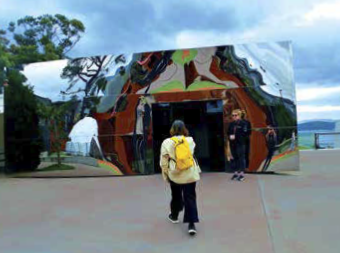
Tiny entrance at MONA, Hobart leading to a massive underground warren full of art
From Little Beach we travelled down to Bicheno where we enjoyed a very nice albeit expensive half lobster lunch at the Lobster Shack for $92 and enjoyed exploring the blowhole.
From Bicheno it was south again until we hit the Freycinet Peninsula. At the Freycinet National Park Visitor Centre we discovered that there were no available spaces left in any of the campgrounds, so we headed halfway back up the Peninsula to the free camp at Swan River Campground beside Swanwick Bay. The next day we hiked to the Wineglass Bay lookout, but not down to the actual bay itself as it was too slippery after recent rains. Even so, the lookout and walkways had all been improved greatly since our last visit many years ago, and the walk up to the lookouts was very enjoyable.
The next day we headed back up the Freycinet Peninsula and checked out the Cape Tourville Lighthouse and Lookout, stopping via Devil’s Corner for some lunch and to enjoy the scenic views across the pretty Moulting Lagoon. From there we continued south through Swansea, Rocky Hills, and Little Swanport down to Triabunna. Here we stayed for free behind the Spring Bay Hotel and booked our next day’s trip to Maria Island. The wharf at Triabunna is full of interesting ships and trawlers — including a squid trawler bedecked with hundreds of very bright lights. The local streets have informative signs for a number of historic buildings and the pub serves excellent meals. The following day we boarded the Encounter Maria Ferry for a short trip across to Maria Island. We walked for the whole day exploring the old convict buildings, the Fossil Cliffs and the wonderful Painted Cliffs, returning to the Spring Bay Hotel for another free night’s camping and another tasty meal.
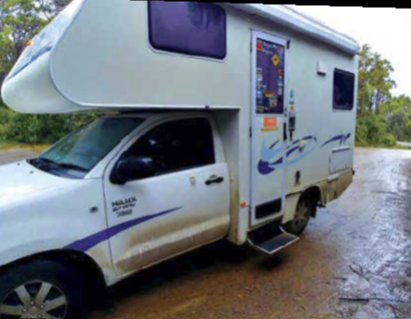
Rain, hail, snow and four degrees overnight near the top of Hartz Mountain in Summer
HOBART AND THE DEEP SOUTH
Now it was south to Hobart via Orford, Buckland, Sorell, and then to Richmond where we enjoyed learning about the town’s history. We also stocked up on supplies before heading into Hobart. There are very few places for people with RVs to stay in Hobart, so we chose the Hobart Discovery Park and enjoyed a fully connected site including a TV connection and an ensuite all to ourselves! There were only eight such sites, with the rest of the park comprised of cabins.
The next morning we took the bus into the heart of Hobart and enjoyed walking about Elizabeth Street Pier, Constitution Dock, and the famous Salamanca Markets where we bought berries, some excellent smoked salmon, a beautiful wooden book cover, and carved wooden coasters for gifts. We returned to our Discovery Park site in Hobart by bus and enjoyed the hot showers and television reception.
The following day we headed off to MONA and enjoyed a great morning and early afternoon thoroughly exploring this amazing art gallery. Later that afternoon we visited the Cascades Female Factory Historic Site, sampling a tray of beers at the nearby Cascade Brewery. We then drove a little west and south to the new CMCA RV Park at Geeveston, where we met the very friendly volunteer camp host.
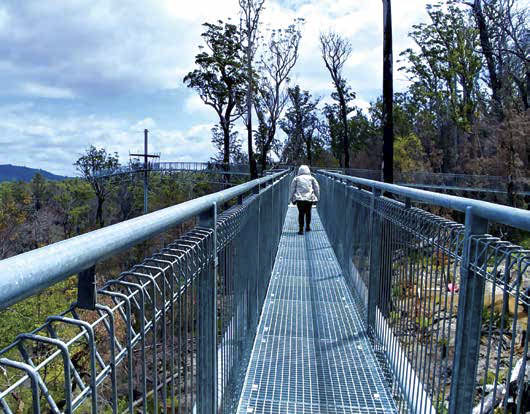
Tahune Adventures Airwalk
Geeveston is full of marvellous wooden statues of local notables, some at street corners, some surrounding the bakery, and many others inside the Information Centre. The CMCA RV Park at Geeveston is right beside the Kermandie River, a recognised Platypus Sanctuary. We strolled along the river in the afternoon and the next morning, but sadly failed to spot a platypus despite others posting their Kermandie River platypus sightings online.
From Geeveston we headed further west and south along the Arve Road to Tahune Adventures and its spectacular Airwalk, a metal walkway built 50m above the ground traversing the upper canopies of the trees above the Huon River. On that particular afternoon the winds were blowing near 80km/h and the Airwalk was closed, so we returned via Hartz Road and then up a winding dirt trail about 10km into the Hartz Mountain. We stayed here overnight near the Waratah Lookout which had a great walk down to the nearby waterfalls. It was around four degrees overnight and we were thankful for the new cheap diesel heater I’d installed recently, which worked a dream to keep us warm.
After that very cold night we travelled to Arve Falls, from which we hiked to Lake Osborne. At many times during our walks this day it lightly snowed — in January — but we were prepared with decent footwear and clothing. This was a wonderful mountain walk passing through an ancient glacial valley and high alpine meadows rich with fabulous alpine flora. After returning to the shelter we then went back down the mountain road to the Tahune Adventures Centre, which had now reopened. We could now experience the Airwalk. This was worth the wait, but the area had been badly affected by bushfires the year before with a lot of dead trees and vegetation to be seen.
From Tahune we drove back through Geeveston and turned south, now heading towards another of the points of this trip to Tasmania — the Southernmost accessible point in Tassie, Cockle Creek. We didn’t quite get to Cockle Creek, instead staying at the free camp at Finn’s Beach at Catamaran, just north of Cockle Creek.

The End of the Road at Fishers Point, near Cockle Creek with its marvellous Southern Right Whale monument
The next morning we headed out to the furthest point — the ‘End of The Road’ — and walked to Fisher’s Point. At the carpark lookout is an amazing monument of a full-sized Southern Right Whale. Cockle Creek is also the start of both the South Cape Bay walk and the much longer South Coast Track Walk (6-8 days), neither of which we did this time around.
Next we headed north, dropping into the Hastings Caves, Thermal Springs, and then on to Southport which boasts the southernmost pub in Australia. Here we enjoyed a fabulous, very well priced lobster lunch — $50 for a full lobster with chips and salad for two. Then it was back up the Huon River past Geeveston and Huonville, then east and south to Kettering where we stayed for free in the carpark of the Oyster Cove Inn, just up the road from the Bruny Island ferry terminal. We had already booked our ferry passage to Bruny Island online the night before.

Cape Bruny Lighthouse, Bruny Island
BRUNY ISLAND
Early next morning we headed down Ferry Road and hopped onto the ferry for its first passage of the day, arriving at Bruny Island nice and early on a beautiful sunny day. From the boat ramp at Robert’s Point it’s not far down to the lookout at The Neck, a spectacular narrow isthmus joining North Bruny to South Bruny Island. Climbing the several hundred steps to the peak of the lookout here to see across the narrow strip of land that is The Neck is a must for anyone visiting Tasmania. Also at the top you will see the plaque for Queen Truganini, born on Bruny Island in 1812, who died in Hobart in 1876 and was incorrectly considered to be the last Indigenous Tasmanian. It is a most fitting and auspicious memorial to her as she looks out over Bruny Island.
From The Neck we travelled south to Adventure Bay, where we went on a 3-hour cruise with Bruny Island Cruises. A bright yellow boat that whisked us around the corner of Bruny Island to blowholes, stunning cliff faces, two seal colonies, flocks of Albatross and Short-tailed Shearwaters hunting at sea, and a glorious pod of dolphins that raced our boat. My wife was glad when it finished thanks to the swells the seasickness they brought.
We were then off to find a camp for the night, heading back west near Lunawanna then south to Cloudy Bay to The Pines free campsite. This site was already a bit full and the ground uneven, so we ventured a little more south and found an amazing spot just right for a single small vehicle. It looked out to the Southern Ocean with the picturesque Sheepwash Creek emptying into the ocean just below us. We were lucky to find this spot vacant, and for the rest of the afternoon and evening a lot of others drove slowly past us, obviously envious or annoyed that we had beaten them to this spot.
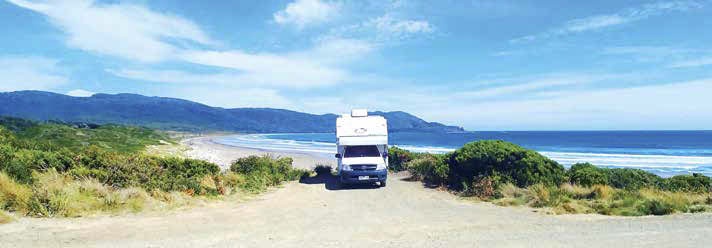
The best overnight stopping spot for just a single vehicle — Cloudy Bay, Bruny Island
Cloudy Bay is popular with surfers and with the carpark to the surf beaches was only a short walk away, we spent some of the next morning exploring the coast of this isolated and harshly beautiful part of Tasmania. As we prepared to leave our wonderful spot there was someone else already waiting to take it.
From Cloudy Bay we travelled back North to Lunawanna and then south again down Lighthouse Road, about 20km to the Bruny Island Lighthouse at the far south-west tip of the Island. As well as the lighthouse and magnificent views, there are also a couple of historic buildings open for viewing. It was then back up the dirt road to Lunawanna, where we stopped for a very nice lunch at the Bruny Island Premium Wines restaurant, enjoying some local produce and wine including some amazing home-made wallaby biltong.
Before leaving Bruny Island we stopped at Bruny Island Honey, near the small airfield on North Bruny, for some unusual honey that is hard to find on the mainland. That afternoon we arrived back to the ferry terminal, then back at Kettering then drove to Hobart for the night.
Category: Unknown
Written: Tue 01 Jun 2021
Printed: June, 2021
Published By:
DAVID MUTCH AND HUA ZHANG V76754